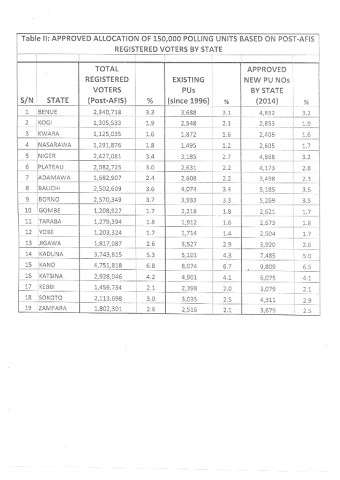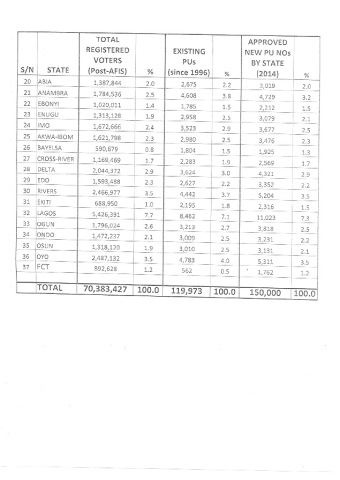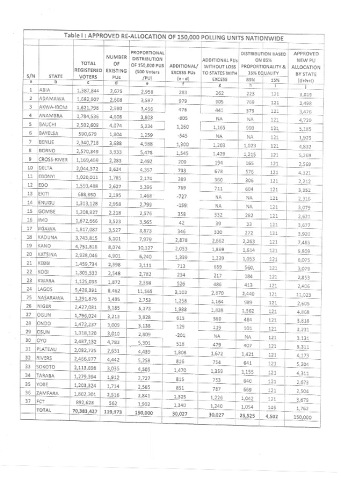AN ADDRESS AT A PRESS CONFERENCE ON THE NEW POLLING UNITS STRUCRTURE BY HON. CHAIRMAN, INDEPENDENT NATIONAL ELECTORAL COMMISSION (INEC), PROFESSOR ATTAHIRU M. JEGA, OFR, ON WEDNESDAY, SEPTEMBER 10, 2014.
Introduction
In recent times, the Independent National Electoral Commission (INEC) has come under unjustified criticism from certain interests over its decision to sanitise the Polling Units (PUs) structure ahead of the 2015 general elections. The criticism has centred largely on an alleged conspiracy theory, to namely: that the Commission has done a disproportional distribution of the polling units across Nigeria under the new arrangement, which is aimed at foisting the dominance of one section of the country over the others for political advantage. It is quite understandable, albeit regrettable that, given the low level of public trust in governance institutions in our clime, and the acrimony that attends to the “distribution” or “allocation’” of virtually anything in our country, people tend to view every policy decision with some suspicion. But we must be careful not to reduce patriotic causes to primordial biases.
INEC’s decision to re-configure the structure of polling units as well as create additional ones is driven by our collective aspirations as Nigerians to reform and improve upon the electoral process for free, fair, peaceful and credible elections in 2015 and beyond. There is no sectional or parochial agenda in this decision, as this press conference will prove, and there will never be any such agenda under this Commission.
The basic aim of the exercise we are presently undertaking is to ease the access of voters to the ballot box in the 2015 general elections and beyond, by:
(i) decongesting over-crowded PUs and dispersing voters as evenly as possible among all the PUs;
(ii) locating PUs more effectively within commuting distances of voters, given that movement is usually restricted on Election Day.;
(iii) relocating the PUs from “in-front of” private houses, and such other unsuitable places, to public buildings or where this is not possible, to public open spaces where tents can be provided;
(iv) locating the PUs inside classrooms or such other suitable enclosures, in line with international best practices;
(v) splitting large PUs such that they have on average of 500 registered voters; and
(vi) creating additional PUs to cater for the splitting of large polling units as well as new settlements not serviced by any existing PU.
Background and Context
The present structure of polling units was created in 1996 by the defunct National Electoral Commission of Nigeria (NECON), which created 120,000 polling units and 8,809 wards (Registration Areas). This structure of polling units has been used for the 1999, 2003, 2007, and 2011 general elections. We are all witnesses to the congested polling units on election days in 2011 and since then in many parts of the country.
From 1996 to date, there has been an exponential growth in Nigeria’s population; and there have been severe demographic shifts resulting from new settlements in major urban areas. For example, in 1996 when the current polling unit structure was established, the estimated population of the Country was about 110m. In 2006, after a national population census, the population was 140m. In 2011, when the voters’ registration was undertaken, the population was estimated to be about 160m. Today the population is estimated to be around 175m. This represents nearly 60% rise in the population since 1996.
These factors have, among other things, translated to over-crowded polling units and the fact that some established settlements are not serviced at all under the existing structure, as we witnessed in the 2011 general elections and in other elections thereafter.
This rise in population, with corresponding increase in the number of eligible voters was clearly manifested during the 2011 fresh voter registration exercise. At the end of the exercise, having subjected the data gathered in the field to Automated Finger-print Identification Software (AFIS) to detect and eliminate duplicate registrants, the Commission certified the total number of registered voters, post-AFIS at 70,383,427. This gives an average voter density of nearly 590 voters per PU with the current number of polling units of 119,973. The reality, however, for most of the large cities in the country, was different. For instance, the FCT with a figure of registered voters of 892,628, and a total of 639 PUs and sub-Units (562 Pus and 77 sub-Units), has an average of nearly 1,400 voters per polling unit, with some having over 3,000 and one even with over 4,000 registered voters! For the same FCT for example over 80% of the polling units have 750 or more registered voters each. For the rest of the Country, 17 states have at least over 30% of their polling units having more than 750 registered voters, with some having 60% or 50% of the polling units affected.
In order to ameliorate the challenges of managing polling units with large number of voters, the Commission introduced the concept of “Voting Points” (VPs); where polling units with large numbers of voters are sub-divided into multiples of manageable numbers of about 300, with a maximum of 450 registered voters, which when exceeded, the polling units are split into 2 or more voting points, in multiples of about 300 registered voters per voting point.
The use of voting points has continued to elicit suspicion by political parties in the run-up to elections, with some even accusing the Commission of secretly creating additional polling units, while some parties are even demanding they be allowed to have polling agents at every voting point! The continuation of the use of voting points is simply incongruent with the reforms the Commission is introducing in terms of the use of enclosures for more conducive voting environment, in tandem with international best practice, apart from the fact that the Commission will require some 250,000 card readers instead of the 160,000 it plans to use in the 150,000 polling units; thereby saving some 90,000 card readers and over 2 billion Naira in costs.
It is therefore imperative for the Commission to re-configure and create additional polling units, if we are to improve on the conduct of elections and make 2015 better than 2011.
About 150,000 polling units are required to ensure right-sizing of our polling units based on the number of registered voters. There is no gain-saying the fact that there have been demographic shifts across the country since 1996 when the current structure was established. Many cities have seen sizable new settlements developed. Most of the new settlements have no polling units located in them or in fact even within reasonable distances. This phenomenon was amply demonstrated when the Commission, working together with the office of the Surveyor-General of the Federation (OSGOF) and the National Population Commission (NPopC), developed composite maps showing satellite imagery overlain with communities and geo-referenced locations of the existing polling units. In FCT, for example in AMAC alone, APO Gwari resettlement Area, Asokoro New Extension, FCDA Quarters Area 3/CBN Quarters before Garki village, Games Village, and many others have no polling units; In Kuje Area Council, Union Homes along Tukpeki Road, there is no polling unit; in Bwari Area Council Kontagora Estate behind Hajj camp, and many others have no polling units.
From the foregoing, it is clear that to ensure the 2015 general elections are conducted under more orderly and conducive atmosphere, thereby creating an environment for free, and fair election, and consolidating the gains of 2011 general elections, additional polling units must be created as described above.
Methodology for Re-configuring and creating new Polling Units
Using the 2011 post-AFIS voters’ register figure of about 70,383,427, and based on a figure of 500 voters per polling unit, there should be at least 140,000 polling units in the country. Taking into cognisance polling units in remote areas and difficult terrains, with less than 500 registered voters, as well as new registrants since 2011, a new total polling unit number nationwide of about 150,000 was approved by the Commission.
Since PUs are created to service registered voters, the fairest and most logical criterion to use in distributing the 150,000 PUs nationwide is the number of registered voters. At present the post-AFIS (i.e. after removing duplicate registrants) figure of registered voters is the most appropriate figure of registered voters that is available nationwide, to use; hence the decision to use post-AFIS figures, as the basis for distributing the 150,000 polling units.
The simplest way to distribute the 150,000 polling units is to divide the number of registered voters in each state by 500 (maximum of registered per polling unit). This is what is shown in column (e) in the attached Table 1 to this press statement. Comparing this column with that of number of existing polling units in each state, i.e. column (d) shows that some states have more than what they should have based on 500 registered voters per polling unit. Redistributing the 150,000 polling units based purely on 500 registered voters per state would mean these states will lose polling units, as they have more polling units than they should have.
The Commission took the view that no state should lose any polling unit as a result of this exercise, as it would be unrealistic to reduce the number of polling units from any state, notwithstanding the fact that they had exceeded their numbers. Thus these states were allowed to retain their excess polling units.
In fact the Commission went on to give further relief to such states by providing that 15% of the 30,027 additional polling units be distributed equally across all states, including the states that had already exceeded their numbers. This was in the spirit that each state should have, no matter how small, some additional polling units during this exercise, in order to carter for new settlements, due to demographic shifts. As a result even the states that had exceeded their numbers, received additional 121 polling units over and above their retained excess.
This is how the distribution of 150,000 PUs nationwide as contained in attached Table I was arrived at. Table II shows an analysis state by state, of the number of polling units, related to the number of registered voters in each state, compared with the existing and new distributions in percentage terms. It is evident from the Table II that the new distribution of polling units is much more equitable than previously.
From the forgoing it is clear that the Commission has used very scientific, rational and equitable criteria to redistribute the 150,000 polling units. In fact in its effort to carry every one along, the Commission bent over backwards to not only allow states with excess polling units based on their voter strength retain the polling units, but made it possible for them to even get additional polling units.
Spurious Allegations
Critics have bandied about spurious allegations, which need to be specifically addressed. I wish to do so in what follows:
Why did INEC adopt the Post-AFIS register of voters and not the Post-Business Rule register of voters as the baseline for calculating the number of PUs?: At the end of the general registration of voters in 2011, the Commission announced that the data of 73. 5 million eligible voters had been captured – warts and all; that is, including the records of multiple (Emphasis: not “ghost”) registrants. At the conclusion of data de-duplication with the Automated Fingerprint Identification Software (AFIS), by which cases of multiple registrations were eliminated, the figure came down to 70,383,427 registered voters. These are genuine, non-multiple, identifiable registrants; and so, potentially eligible as voters. Critics have made much issue about this figure declining further in the ‘Post-Business Rule Register.’ The fact, however, is that during the registration exercise, the general requirement was to capture the 10 fingerprints of every registrant. But as we have discovered in the process of data consolidation, some registrants did not have their fingerprints properly captured; and so did not satisfy the ‘business rule’ we adopted for producing Permanent Voter Cards (PVCs), namely that every registrant must have in his/her biometric record a minimum of four fingerprints (two on each hand) so that the PVC will be machine-readable in the 2015 elections. The affected persons remain potentially eligible as voters, and are expected to come out during the Continuous Voter Registration (CVR) exercise to get their data recaptured. For polling unit configuration that will serve in 2015 and well into the future, therefore, we cannot reasonably plan without taking account of this set of potentially eligible voters; otherwise we would need to undertake another exercise of polling unit creation when they come out to get their data recaptured, as they really are expected to do.
On alleged Zonal disproportion in the distribution of the polling units: Based on the statistical projections I earlier explained, the ‘need factor,’ more than political sentiments, informed the pattern of distribution of the PUs that we are creating. Still, the Commission has not been unmindful of the political nature of the exercise; and that is why it took the decision that: (i) No state will lose any polling unit from its stock of existing PUs, no matter the statistical outlook when the voter population is disaggregated into units of 500 persons; and (ii) Every state will get some additional polling units from 15% of the total being newly created on the basis of ‘equality principle’ – regardless of the number of PUs already existing in each state in comparison to the voter population. We have already made the computed figures in this regard public. Contrary to the argument by critics, the Commission is not working on imaginary population sizes based on perceived patterns of migration by potential voters; rather, it is working with the documented register of voters as we have it at the moment. Furthermore, critics seem to only focus on the allocation of the proposed 30,027 PUs; what should be done is to compare total allocations state by state. Thus we urge Nigerians to closely examine the attached tables and compare the proportional distribution of PUs presently in existence and the proposed new distribution. It will be clear that there is no significant variation in the proportional percentage allocation, amongst states, or between geopolitical zones.
On the numbers of polling units being allocated to respective state: The additional 30,027 polling units, as I have observed, are being created to address the issue of crowd clusters under the present structure. Therefore, the distribution could not be even among all the states because the challenge being addressed is not evenly present in all the states. We have used voting points since 2011 to mitigate the problem of crowd clusters. Talking about numbers, critics of the exercise should ask: in which states have we had more voting points created in existing PUs than others since 2011; and then, they should check whether the distribution profile of the new PUs does not reflect the proportion of that informal arrangement.
Does the number of polling units confer any political advantage on a state / region? With the structure of the political process put in place by the present INEC, the answer simply is ‘No!’ Polling Units constitute a mere structural arrangement to ease the access of voters to the ballot box. They have nothing to do with determining the preferences of voters in making their electoral choices. In fact, the new configuration we are putting in place will bring the PUs out to places where they can be accessed more easily – not only by voters, but by polling agents of political parties and election observers as well. This will enhance, rather than detract from the integrity of the electoral process.
For the avoidance of doubt, the Commission has not yet created the additional Polling Units. It has simply approved the framework and guidelines to facilitate the creation of these additional Polling Units by the Resident Electoral Commissioners and the State Offices of INEC. In collaboration with other government agencies, especially OSGOF, we have even produced Maps with the GIS location of existing Polling Units nationwide, in order provide the states a rational, scientific basis for the practical exercise of re-configuring and locating additional PUs. It is only when the states have used the framework and guidelines and have proposed the new PUs for each state, that the Commission will create the PUs.
From the explanation we have provided, I must therefore emphasize that the motive of INEC in restructuring the existing polling units and creating more is sincere and well-intentioned. The Commission implores all Nigerians to set aside primordial sentiments and view the exercise with dispassion and patriotism, taking into account the lofty objectives that the new structure of polling units is intended to achieve.
Finally, I wish to categorically state that all the conspiracy theories and mischievous assertions and perceptions of parochial intentions of the Commission are totally false. INEC remains focused and committed to taking patriotic decisions, which are in the best interest of our country and the voters, so as to keep on satisfying the aspirations of Nigerians for free, fair, peaceful and credible elections. We will continue to do this with the best standards of integrity, impartiality and non- partisanship expected of us an Election Management Body.
I hope that with this clarification, we will put the unnecessary and unwholesome controversy on the matter of additional polling units to rest.
Thank you.
God bless the Federal Republic of Nigeria.
Professor Attahiru M. Jega, OFR
CHAIRMAN, INDEPENDENT NATIONAL ELECTORAL COMMISSION (INEC)










